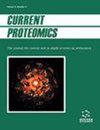Differential Proteomic Identification and Bioinformatics Analysis of Femoral Neck in Elderly Female Patients with Hyperuricaemia
IF 0.5
4区 生物学
Q4 BIOCHEMICAL RESEARCH METHODS
引用次数: 0
Abstract
Serum uric acid (UA) is positively correlated with bone mineral density (BMD). However, the mechanism by which serum UA affects BMD remains unclear. The aim was carried out to search for the functional proteins related to serum UA and femoral neck BMD to better understand the pathophysiological mechanism of osteoporosis. In this study, patients in the UA group (hyperuricaemia combined with femoral neck fracture) and the control group (normal uricaemia combined with femoral neck fracture) were selected according to the inclusion criteria. Total protein was extracted from the femoral neck of each patient. Fluorescence differential gel electrophoresis was used to separate the total proteins, and the differentially expressed protein spots were detected by image analysis. After enzyme digestion, peptide mass fingerprinting and database searches were performed to identify the differentially expressed proteins. DAVID software and Kyoto Encyclopedia of Genes and Genomes (KEGG) data were used for enrichment analysis of the screened differential proteins. After mass spectrometry and database searching, 66 differentially expressed protein spots were identified between the UA group and the control group. Most differentially expressed proteins functioned in cytoskeleton formation, energy metabolism, or signal transduction. They were mainly involved in 50 biological processes, including peroxisome proliferator-activated receptor (PPAR) signalling and fatty acid metabolism. PPARγ and PLIN1 were subject to Western blotting analysis detection; results were consistent with the Label-Free result. Based on an analysis of the biological information, these proteins may be associated with the incidence and progression of the femoral neck bone tissues of hyperuricaemia patients.老年女性高尿酸血症患者股骨颈差异蛋白质组学鉴定及生物信息学分析
血清尿酸(UA)与骨密度(BMD)呈正相关。然而,血清UA影响BMD的机制尚不清楚。目的是寻找与血清UA和股骨颈骨密度相关的功能蛋白,以更好地了解骨质疏松症的病理生理机制。本研究根据纳入标准选择UA组(高尿酸血症合并股骨颈骨折)和对照组(正常尿酸血症合并股骨颈骨折)患者。从每位患者的股骨颈提取总蛋白。采用荧光差示凝胶电泳法分离总蛋白,通过图像分析检测差异表达蛋白斑点。酶解后,进行肽质量指纹图谱和数据库检索,以鉴定差异表达蛋白。利用DAVID软件和京都基因与基因组百科全书(KEGG)数据对筛选的差异蛋白进行富集分析。经质谱分析和数据库检索,UA组与对照组之间鉴定出66个差异表达蛋白点。大多数差异表达蛋白在细胞骨架形成、能量代谢或信号转导中起作用。它们主要参与50个生物过程,包括过氧化物酶体增殖物激活受体(PPAR)信号传导和脂肪酸代谢。Western blotting检测PPARγ和PLIN1;结果与Label-Free结果一致。基于对生物学信息的分析,这些蛋白可能与高尿酸血症患者股骨颈骨组织的发生和进展有关。
本文章由计算机程序翻译,如有差异,请以英文原文为准。
求助全文
约1分钟内获得全文
求助全文
来源期刊

Current Proteomics
BIOCHEMICAL RESEARCH METHODS-BIOCHEMISTRY & MOLECULAR BIOLOGY
CiteScore
1.60
自引率
0.00%
发文量
25
审稿时长
>0 weeks
期刊介绍:
Research in the emerging field of proteomics is growing at an extremely rapid rate. The principal aim of Current Proteomics is to publish well-timed in-depth/mini review articles in this fast-expanding area on topics relevant and significant to the development of proteomics. Current Proteomics is an essential journal for everyone involved in proteomics and related fields in both academia and industry.
Current Proteomics publishes in-depth/mini review articles in all aspects of the fast-expanding field of proteomics. All areas of proteomics are covered together with the methodology, software, databases, technological advances and applications of proteomics, including functional proteomics. Diverse technologies covered include but are not limited to:
Protein separation and characterization techniques
2-D gel electrophoresis and image analysis
Techniques for protein expression profiling including mass spectrometry-based methods and algorithms for correlative database searching
Determination of co-translational and post- translational modification of proteins
Protein/peptide microarrays
Biomolecular interaction analysis
Analysis of protein complexes
Yeast two-hybrid projects
Protein-protein interaction (protein interactome) pathways and cell signaling networks
Systems biology
Proteome informatics (bioinformatics)
Knowledge integration and management tools
High-throughput protein structural studies (using mass spectrometry, nuclear magnetic resonance and X-ray crystallography)
High-throughput computational methods for protein 3-D structure as well as function determination
Robotics, nanotechnology, and microfluidics.
 求助内容:
求助内容: 应助结果提醒方式:
应助结果提醒方式:


